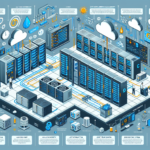Optimizing server rack density is a key goal for maximizing the efficiency of your data center while balancing cooling, power, and physical space constraints. Here are several strategies to help you optimize server rack density effectively:
1. Use High-Density Server Hardware
- Deploy Blade Servers or High-Density Rack Units: Blade servers and high-density rack servers are specifically designed to pack more compute power into less physical space.
- Utilize GPU Servers for AI/ML Workloads: If your applications require GPU processing, invest in GPU-dense servers that consolidate multiple GPUs into a single chassis.
- Choose Storage-Dense Systems: For storage workloads, look for high-capacity storage arrays or servers with multiple hard drive slots.
2. Virtualization and Containerization
- Leverage Virtualization Technologies: Consolidate workloads using hypervisors like VMware, Hyper-V, or KVM to run multiple virtual machines on fewer physical servers.
- Use Kubernetes for Containers: Deploy containerized applications using Kubernetes, which allows multiple applications to run on shared hardware efficiently.
- Resource Optimization: Allocate resources based on workload needs to reduce under-utilization.
3. Optimize Cooling Systems
- Implement Hot/Cold Aisle Containment: Arrange racks in alternating rows of hot aisles and cold aisles to improve cooling efficiency.
- Liquid Cooling Systems: In high-density environments, consider liquid cooling solutions for racks or specific servers to prevent overheating.
- Monitor Airflow: Use blanking panels to prevent hot air recirculation and ensure efficient airflow within racks.
4. Power Management
- Upgrade to High-Capacity PDUs: Use power distribution units (PDUs) capable of supporting higher-density racks without overloading circuits.
- Monitor Power Usage: Use tools to monitor power consumption at the rack and server level to prevent overloading and ensure balanced power distribution.
- Optimize UPS Systems: Ensure uninterruptible power supplies (UPS) can handle the increased density and runtime requirements.
5. Cable Management
- Implement Structured Cabling: Use cable management systems to organize and route cables efficiently, reducing clutter and improving airflow.
- Use Shorter Cables: Minimize cable lengths to reduce obstruction and improve airflow within racks.
6. Rack Design and Layout
- Use Taller Racks: Deploy racks with higher vertical capacity (e.g., 42U, 48U) to fit more equipment within the same floor space.
- Optimize Rack Placement: Distribute weight evenly across racks and ensure racks are placed to maximize cooling efficiency.
- Dynamic Rack Planning: Use adjustable shelves and rails to accommodate a variety of server and storage equipment sizes.
7. Implement Monitoring and Automation
- DCIM Software: Utilize data center infrastructure management (DCIM) tools to monitor rack density, power usage, cooling, and airflow.
- AI-Powered Monitoring: Use AI-driven solutions to predict server loads and dynamically adjust resources to prevent overloading.
- Automated Provisioning: Leverage automation tools to streamline provisioning and optimize server utilization.
8. Consolidate Workloads
- Consolidate Applications and Databases: Reduce the number of servers required by consolidating workloads into fewer, more powerful servers.
- Cloud Offloading: Offload non-critical workloads to the cloud or hybrid environments to free up on-premises rack space.
9. Use Edge Computing for Decentralization
- Deploy edge computing systems to move workloads closer to the end user, reducing the need for centralized high-density racks in the primary data center.
10. Regular Audits and Capacity Planning
- Conduct regular audits of server utilization, power consumption, and cooling efficiency to identify opportunities for further optimization.
- Plan for future growth by designing racks with scalability in mind.
11. Collaboration with Vendors
- Work closely with hardware vendors to select equipment optimized for density and efficiency, such as modular designs, low-power processors, or integrated GPU servers.
By implementing these strategies, you can effectively optimize server rack density while ensuring performance, reliability, and sustainability in your data center environment.
How do I optimize server rack density?




